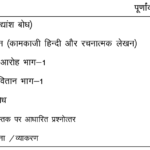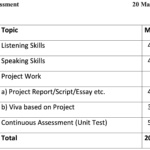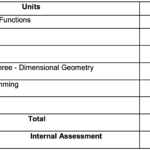The UK Board Class 11th Maths Syllabus for the 2024-2025 academic year is designed to build a strong foundation in mathematical concepts that are essential for higher education in fields such as engineering, science, and technology.
This syllabus is aligned with the NCERT guidelines and focuses on developing analytical and problem-solving skills among students. Check Uttarakhand board 11th syllabus and XI mathematics UK board exam pattern with list of assessments and activities.
Contents
UK Board 11th Maths Syllabus 2024-2025
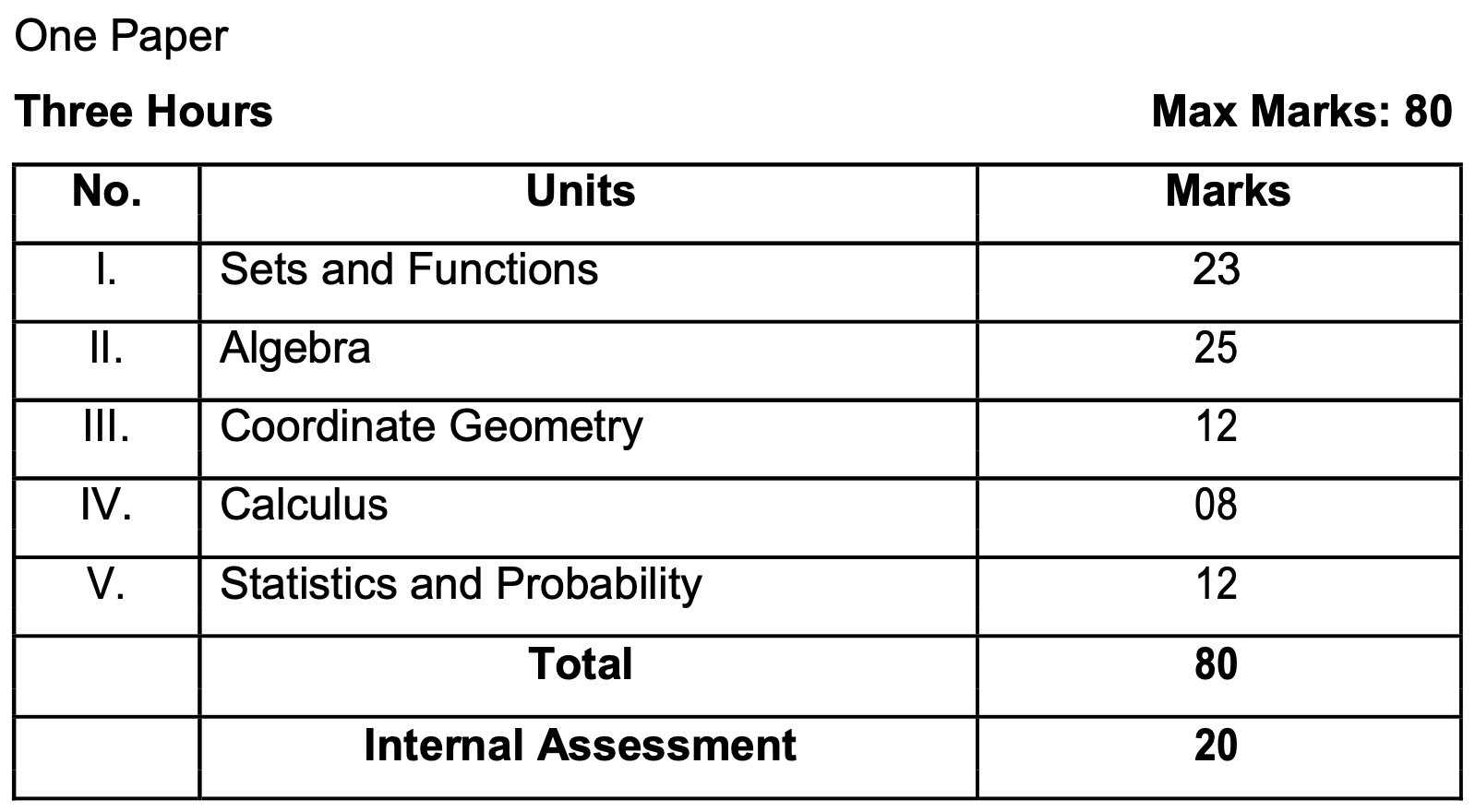
Unit-I: Sets and Functions
- Chapter 1: Sets:- Sets and their representations, Empty set, Finite and Infinite sets, Equal sets, Subsets, Subsets of a set of real numbers especially intervals (with notations). Universal set. Venn diagrams. Union and Intersection of sets. Difference of sets. Complement of a set. Properties of Complement.
- Chapter 2: Relations & Functions:- Ordered pairs. Cartesian product of sets. Number of elements in the Cartesian product of two finite sets. Cartesian product of the set of reals with itself (upto R x R x R). Definition of relation, pictorial diagrams, domain, co-domain and range of a relation. Function as a special type of relation. Pictorial representation of a function, domain, co-domain and range of a function. Real valued functions, domain and range of these functions, constant, identity, polynomial, rational, modulus, signum, exponential, logarithmic and greatest integer functions, with their graphs. Sum, difference, product and quotients of functions.
- Chapter 3: Trigonometric Functions:- Positive and negative angles. Measuring angles in radians and in degrees and conversion from one measure to another. Definition of trigonometric functions with the help of unit circle. Truth of the identity sin2x + cos2x = 1, for all x. Signs of trigonometric functions. Domain and range of trigonometric functions and their graphs. Expressing sin (x±y) and cos (x±y) in terms of sinx, siny, cosx & cosy and their simple applications. Deducing identities like the following:
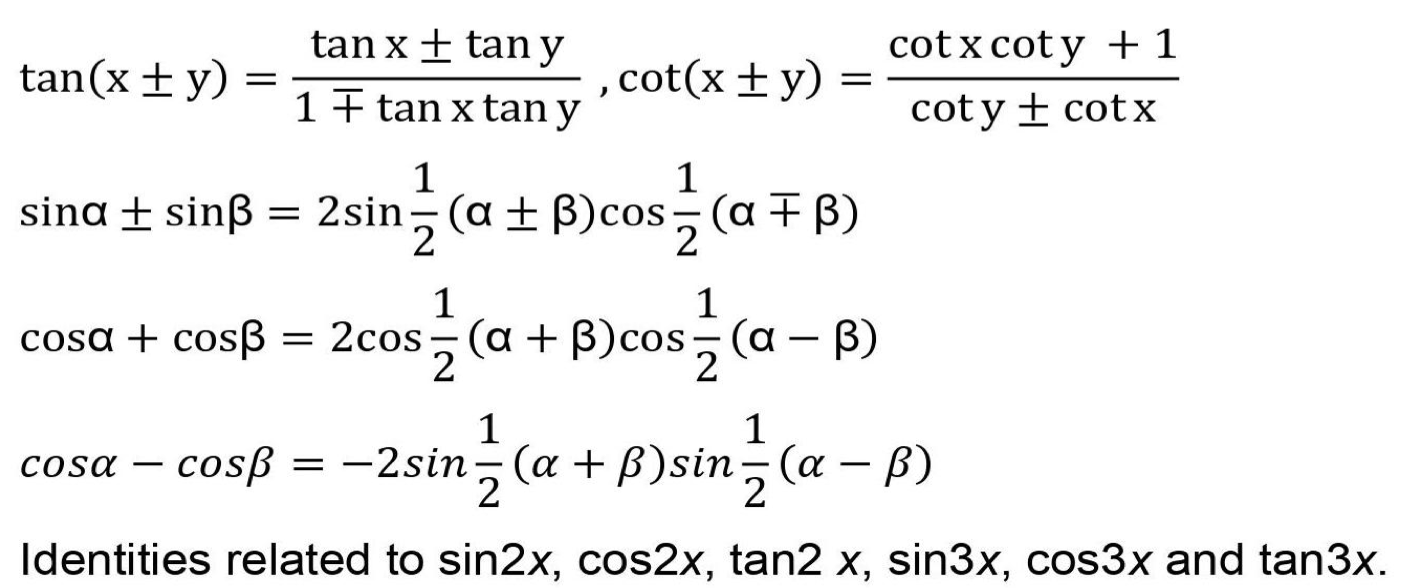
Unit-II: Algebra
- Chapter 4: Complex Numbers and Quadratic Equations:- Need for complex numbers, especially√−1, to be motivated by inability to solve some of the quadratic equations. Algebraic properties of complex numbers. Argand plane.
- Chapter 5: Linear inequalities:- Algebraic solutions of linear inequalities in one variable and their
representation on the number line. - Chapter 6: Permutations and Combinations:- Fundamental principle of counting. Factorial n. (n!) Permutations and combinations, derivation of Formulae for nPr and nCr and their connections, simple applications.
- Chapter 7: Binomial Theorem:- Historical perspective, statement and proof of the binomial theorem for positive integral indices. Pascal’s triangle, simple applications.
- Chapter 8: Sequence and Series:- Sequence and Series. Arithmetic Mean (A.M.) Geometric Progression (G.P.), general term of a G.P., sum of n terms of a G.P., infinite G.P. and its sum, geometric mean (G.M.), relation between A.M. and G.M.
Unit-III: Coordinate Geometry
- Chapter 9: Straight Lines:- Brief recall of two dimensional geometry from earlier classes. Slope of a line and angle between two lines. Various forms of equations of a line: parallel to axis, point -slope form, slope-intercept form, two-point form, intercept form, Distance of a point from a line.
- Chapter 10: Conic Sections:- Sections of a cone: circles, ellipse, parabola, hyperbola, a point, a straight line and a pair of intersecting lines as a degenerated case of a conic section. Standard equations and simple properties of parabola, ellipse and hyperbola. Standard equation of a circle.
- Chapter 11: Introduction to Three-dimensional Geometry:- Coordinate axes and coordinate planes in three dimensions. Coordinates of a point. Distance between two points.
Unit-IV: Calculus
Chapter 12: Limits and Derivatives:- Derivative introduced as rate of change both as that of distance function and geometrically. Intuitive idea of limit. Limits of polynomials and rational functions trigonometric, exponential and logarithmic functions. Definition of derivative relate it to scope of tangent of the curve, derivative of sum, difference, product and quotient of functions. Derivatives of polynomial and trigonometric functions.
Unit-V Statistics and Probability
- Chapter 13: Statistics:- Measures of Dispersion: Range, Mean deviation, variance and standard deviation of ungrouped/grouped data.
- Chapter 14: Probability:- Events; occurrence of events, ‘not’, ‘and’ and ‘or’ events, exhaustive events, mutually exclusive events, Axiomatic (set theoretic) probability, connections with other theories of earlier classes. Probability of an event, probability of ‘not’, ‘and’ and ‘or’ events.
UK Board 11th Mathematics Practical Assessment (Activities) 2024-2025
List of topics covered under Internal Assessment are given in below table:-
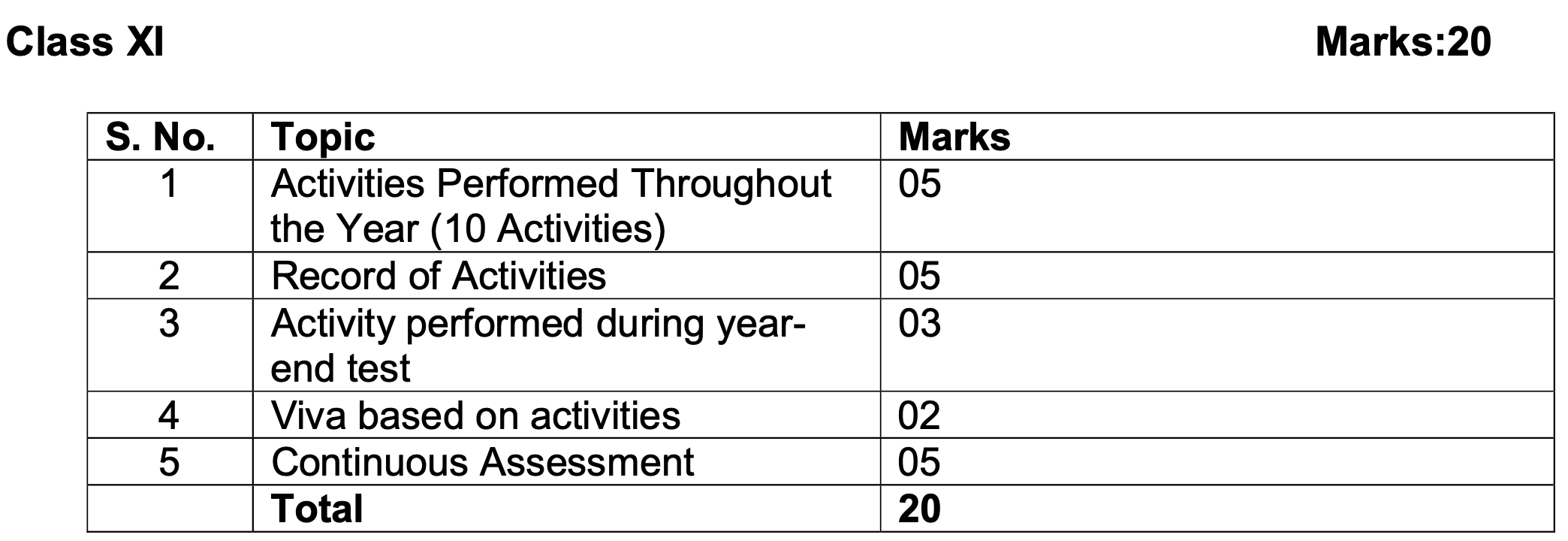
More Links For Uttarakhand Maths Class 11 Syllabus 2024-25
| Subject Name (11th) | Subject Code | Syllabus Link |
| 11th Maths | 128 | CLICK HERE |
| 11th Physics | 129 | CLICK HERE |
| 11th Chemistry | 130 | CLICK HERE |
| 11th Biology | 131 | CLICK HERE |
| 11th Hindi | 101 | CLICK HERE |
| 11th English | 103 | CLICK HERE |
| Latest UBSE Updates | UBSE | CLICK HERE |
| UK Board Class 12th All Subjects Syllabus |
All Subjects | CLICK HERE |
| Official Website | UK Board | CLICK HERE |
Some FAQS
Are there any significant changes in the Class 11th Maths syllabus for this academic year?
The syllabus generally follows the NCERT guidelines, with minor adjustments made by the UK Board to keep the content relevant. It’s recommended to review the official syllabus document provided by the board for any specific changes.
How is the Class 11th Maths exam structured under the UK Board?
The Maths exam consists of a mix of objective, short answer, and long answer questions. These questions are designed to evaluate students' understanding of both theoretical concepts and practical problem-solving abilities.
What is the best way to prepare for the Calculus section in the Class 11th Maths syllabus?
To prepare for Calculus, students should focus on understanding the fundamental concepts of limits, derivatives, continuity, and differentiability. Regular practice of problems and referring to NCERT textbooks is essential. Online tutorials and practice papers can also be helpful.
How important is the topic of Mathematical Reasoning in the Class 11th Maths syllabus?
Mathematical Reasoning is an important topic as it helps develop critical thinking and logical reasoning skills. Understanding this section is crucial for solving complex problems in exams and is also beneficial for competitive exams.
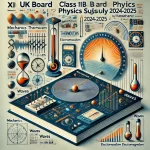

![UK Board Class 11th Biology Syllabus 2024-2025 [XI UBSE Uttarakhand] feature image](https://4syllabus.in/wp-content/uploads/2024/09/UK-Board-Class-11th-Biology-Syllabus-2024-2025-XI-UBSE-Uttarakhand-feature-image-150x150.webp)
